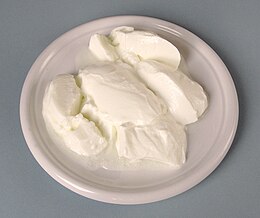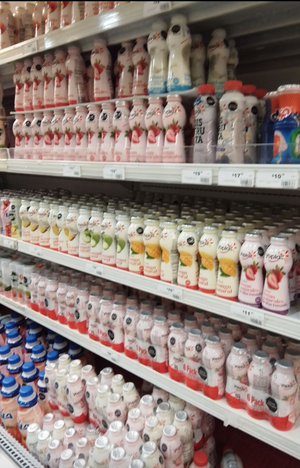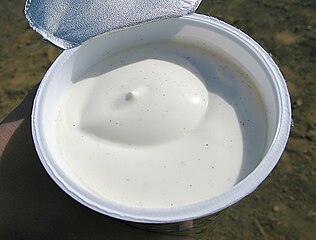Yogurt/ja: Difference between revisions
Created page with "===甘味付き・フレーバー付き=== その自然な酸味を打ち消すため、ヨーグルトは甘味付き、甘味・フレーバー付き、または底にフルーツやフルーツジャムが入った容器で販売されることもある。食料品店で一般的に見られるヨーグルトの2つのスタイルは、セットスタイルヨーグルトとスイススタイルヨーグルトである。セットスタイルヨーグル..." |
No edit summary |
||
| (16 intermediate revisions by the same user not shown) | |||
| Line 180: | Line 180: | ||
その自然な[[sour/ja|酸味]]を打ち消すため、ヨーグルトは甘味付き、甘味・フレーバー付き、または底にフルーツやフルーツジャムが入った容器で販売されることもある。食料品店で一般的に見られるヨーグルトの2つのスタイルは、セットスタイルヨーグルトとスイススタイルヨーグルトである。セットスタイルヨーグルトは個々の容器に注ぎ入れて固まらせるのに対し、スイススタイルヨーグルトは包装前に攪拌される。どちらのスタイルにも甘味を増すためにフルーツが加えられることがある。 | その自然な[[sour/ja|酸味]]を打ち消すため、ヨーグルトは甘味付き、甘味・フレーバー付き、または底にフルーツやフルーツジャムが入った容器で販売されることもある。食料品店で一般的に見られるヨーグルトの2つのスタイルは、セットスタイルヨーグルトとスイススタイルヨーグルトである。セットスタイルヨーグルトは個々の容器に注ぎ入れて固まらせるのに対し、スイススタイルヨーグルトは包装前に攪拌される。どちらのスタイルにも甘味を増すためにフルーツが加えられることがある。 | ||
[[Lassi/ja|ラッシー]]は、インドで一般的な飲料で、攪拌して液状にしたヨーグルトから作られる。塩味または一般的に砂糖で甘味を付け、あまり一般的ではないがハチミツで甘味を付け、フルーツパルプと混ぜてフレーバーラッシーが作られる。粘性は大きく異なり、都市部や市販のラッシーは加工されているため均一な食感を持つが、地方や素朴なラッシーは凝乳塊やフルーツパルプがはっきりと残っている。 | |||
[[Lassi]] | |||
市販のヨーグルトには、多量の砂糖、あるいは低エネルギーヨーグルトの場合は他の[[sweetener/ja|甘味料]]がしばしば使用される。一部のヨーグルトには、とろみとクリーミーさを出すために、[[modified starch/ja|加工デンプン]]、[[pectin/ja|ペクチン]](フルーツに自然に含まれる)、または[[gelatin/ja|ゼラチン]]が添加されている。この種のヨーグルトは、スイススタイルと表示されることがあるが、これは従来の[[Swiss yogurt/ja|スイスヨーグルト]]とは関係がない。一部のヨーグルトは「クリームライン」と呼ばれることがあり、均質化されていない全乳で作られているため、クリームが上部に浮き上がる。多くの国では、甘味付きのフレーバーヨーグルトが一般的で、通常[[:en:single-use|使い捨て]]の[[:en:plastic cup|プラスチックカップ]]で販売されている。一般的なフレーバーには、[[vanilla/ja|バニラ]]、[[honey/ja|ハチミツ]]、[[toffee/ja|トフィー]]、そして様々なフルーツが含まれる。21世紀初頭には、チョコレートやチーズケーキのようなデザートにインスパイアされたヨーグルトフレーバーが一般的になった。その高い糖分含有量により、[[#Nutrition|甘味付きヨーグルトの健康への影響]]が懸念されているが、研究によると、[[:en:World Health Organization|WHO]]や政府の[[obesity/ja|肥満]]対策の取り組みに応じ、2016年以降、ヨーグルト製造における砂糖の使用は減少している。 | |||
===水切り=== | |||
{{main/ja|Strained yogurt/ja}} | |||
{{main|Strained yogurt}} | [[File:StrainYogurt.jpg|thumb|家庭の冷蔵庫でヨーグルトの水切りに使うコーヒーフィルター]] | ||
[[File:StrainYogurt.jpg|thumb| | 水切りヨーグルトは、伝統的に[[muslin/ja|モスリン]]、近年では紙やモスリン以外の布製のフィルターを通して水分を切ったものである。これにより[[whey/ja|乳清]]が取り除かれ、はるかに濃厚な食感になる。特に、薄い食感になりがちなスキムミルクを使う場合、水切りヨーグルトは家庭で作られることがある。乳清をろ過または除去するために水切りされたヨーグルトは、中東諸国では[[Labneh/ja|ラブネ]]として知られている。ヨーグルトとチーズの中間の食感を持つ。中東諸国では[[sandwich/ja|サンドイッチ]]に使われることがある。オリーブオイル、キュウリのスライス、オリーブ、様々な緑のハーブが加えられることもある。さらに濃厚にして丸め、オリーブオイルに保存し、数週間発酵させることもできる。時には玉ねぎ、肉、ナッツと混ぜて様々なパイや[[kibbeh/ja|キッベ]]ボールの詰め物としても使われる。 | ||
一部の水切りヨーグルトは、まず開放式の大きな鍋で煮詰められ、液体の含有量が減らされる。東インドのデザートである、伝統的なダヒの一種である[[mishti doi/ja|ミシュティ・ダヒ]]は、より濃厚でカスタードのような食感を提供し、通常、西洋のヨーグルトよりも甘い。インド西部(マラーティー料理とグジャラート料理)では、水切りヨーグルトが砂糖とサフラン、カルダモン、ナツメグなどのスパイスと混ぜられ、「シュリカンド」というデザートが作られる。水切りヨーグルトはギリシャでも楽しまれており、[[Gyro (food)/ja|ジャイロ]]や[[souvlaki/ja|スブラキ]]のピタサンドイッチのよく知られた付け合わせである「[[tzatziki/ja|ザジキ]]」(トルコ語の{{lang|tr|[[cacık/ja|cacik]]}}が語源)の主成分となっている。これは、すりおろした[[cucumber/ja|キュウリ]]、[[olive oil/ja|オリーブオイル]]、塩、そして任意でつぶしたニンニクを加えたヨーグルトソースまたはディップである。インドのデザートである[[Srikhand/ja|シュリカンド]]は、水切りヨーグルト、[[saffron/ja|サフラン]]、[[cardamom/ja|カルダモン]]、[[nutmeg/ja|ナツメグ]]、砂糖、そして時には[[mango/ja|マンゴー]]や[[pineapple/ja|パイナップル]]のような果物から作られる。 | |||
北米では、水切りヨーグルトは一般的に「ギリシャヨーグルト」と呼ばれている。濃厚にするために、水切りの代わりに粉乳が加えられることもある。イギリスでは、「ギリシャ」という名称はギリシャで作られたヨーグルトにのみ適用される。 | |||
===飲料=== | |||
=== | アイラン、[[doogh/ja|ドゥーグ]]([[:en:Assyrian Neo-Aramaic|ネオアラム語]]では「dawghe」)またはダッレは、ヨーグルトベースの塩味の飲み物である。ヨーグルトを水と(時には)塩と混ぜて作られる。 | ||
[[Borhani/ja|ボルハニ]](またはブルハニ)は、[[:en:Bangladesh|バングラデシュ]]のスパイシーなヨーグルトドリンクである。結婚式や特別なごちそうの際に、カッチ[[biryani/ja|ビリヤニ]]と共に供されることが多い。主な材料は、[[mentha/ja|ミント]]の葉、[[mustard seeds/ja|マスタードシード]]、[[Kala Namak/ja|ブラックロックソルト]]とブレンドされたヨーグルトである。挽いたロースト[[cumin/ja|クミン]]、挽いた[[white pepper/ja|白コショウ]]、青[[chili pepper/ja|唐辛子]]ペースト、砂糖がよく加えられる。 | |||
[[Borhani]] | |||
[[Lassi/ja|ラッシー]]はヨーグルトベースの飲料で、通常はわずかに塩味または甘味があり、市販品では[[rosewater/ja|ローズウォーター]]、[[mango/ja|マンゴー]]、その他のフルーツジュースで風味付けされることもある。塩味のラッシーは通常、挽いたローストクミンと[[chili pepper/ja|赤唐辛子]]で風味付けされ、[[buttermilk/ja|バターミルク]]で作られることもある。 | |||
[[Lassi]] | |||
無糖・無塩のヨーグルトドリンクは、[[:en:Balkans|バルカン半島]]では通常単に「ジョグルト」と呼ばれ、[[burek/ja|ブレク]]などの焼き菓子と一緒に飲まれている。ヨーロッパ(イギリスを含む)やアメリカでは、甘味のあるヨーグルトドリンクが一般的で、フルーツや甘味料が加えられている。これらは通常「ドリンクヨーグルト」と呼ばれているね。また、フルーツの割合が多く、[[smoothie/ja|スムージー]]に近い「ヨーグルトスムージー」も販売されている。 | |||
[[File:Drinkable Yogurt.png|thumb|販売中のドリンクヨーグルト]] | |||
[[File:Drinkable Yogurt.png|thumb| | |||
==製造{{Anchor|Production}}== | |||
==Production== | [[File:Joghurtgerät.JPG|thumb|right|市販の家庭用ヨーグルトメーカー]] | ||
[[File:Joghurtgerät.JPG|thumb|right| | ヨーグルトの製造は、まず温かい牛乳を、牛乳をヨーグルトに変える生きた[[microorganism/ja|微生物]]を殺さない温度(30〜45℃/86〜113°F)に準備することから始まる。次に、通常''[[Streptococcus thermophilus/ja|Streptococcus thermophilus]]''と''[[Lactobacillus bulgaricus/ja|Lactobacillus bulgaricus]]''という特定の細菌([[starter culture/ja|スターターカルチャー]])を牛乳に接種し、最後に数時間(4〜12時間)温かく保つ。 | ||
通常の牛乳よりも固形分濃度が高い牛乳が使われることもある。固形分が多いほど、よりしっかりとしたヨーグルトができるからだ。固形分は乾燥乳を加えることで増やすことができる。 | |||
ヨーグルトの製造工程は、[[pathogen/ja|病原体]]の増殖に対して2つの重要な障壁を提供する。それは熱と酸性度(低いpH)である。どちらも安全な製品を保証するために必要だ。酸性度単独の効果は、酸耐性のある''[[Wikipedia:E. coli O157:H7|E. coli O157:H7]]''による食中毒が最近発生したことで疑問視されている。''E. coli O157:H7''は低温殺菌(加熱)によって容易に破壊される。牛乳の最初の加熱は、病原体を殺すだけでなく、タンパク質を変性させる効果もある。牛乳をヨーグルトに変える微生物は、ほとんどの病原体よりも高い温度に耐えることができるため、適切な温度はヨーグルトの形成を促すだけでなく、病原性微生物の増殖を抑制する。ヨーグルトが形成された後、必要であれば、[[Strained yogurt/ja|水切り]]をして乳清の含有量を減らし、濃くすることができる。 | |||
==微細構造{{Anchor|Microstructure}}== | |||
== Microstructure== | ヨーグルトは、[[:en:Newtonian fluid|ニュートン流体]]である牛乳が発酵し、タンパク質の凝集とそれに続く[[gelation/ja|ゲル化]]を引き起こすことで形成される、粘性があり、[[:en:shear-thinning|せん断減粘性]]を示す[[:en:non-Newtonian fluid|非ニュートン流体]]として特徴づけられる。その結果生じる柔らかい固体は、カゼインタンパク質の相互作用を介してモデル化することができる。ヨーグルトの[[microstructure/ja|微細構造]]は、脂肪とタンパク質の両方の含有量、およびヨーグルトの加工条件によって影響を受ける。低脂肪配合では、微細構造はクラスターとストランドを介して結合したカゼインタンパク質小球のネットワークであり、細孔を包み込んでいる。これらの細孔は、水相とヨーグルトの細菌培養物を収容する。 | ||
攪拌されたヨーグルトの配合は、混合プロセス中に誘発される[[:en:shear forces|せん断力]]とそれによる粒子間の衝突のため、緩やかに結合したカゼイン粒子のより粗い分布を持つ。攪拌後、ヨーグルトは弱ゲルとしてより正確に定義される。 | |||
===レオロジー(Rheology)=== | |||
===Rheology === | |||
ヨーグルトの機械的特性は通常、[[:en:rheometry|レオメトリー]]を用いて評価される。これは、せん断力を受けた軟質材料の変形と流動応答を定量化するものである。[[:en:materials science|材料科学]]の中心であるように、ヨーグルトのレオロジー的特性は、乾物と湿物の比率、熱処理、牛乳の起源、スターターカルチャー、ヨーグルトの種類など、様々な加工要因によって決定される。 | |||
牛乳はヨーグルト製造の一般的な選択肢であるが、ヤギ乳、羊乳、ラクダ乳などの他の乳は異なるレオロジー特性を生み出す。ヤギ乳ヨーグルトは、牛乳ヨーグルトと比較して粘度が低く、より薄いテクスチャを持つ。逆に、羊乳は固形分含有量が高いため、牛乳ヨーグルトと比較して粘度が高く、より濃厚なテクスチャを持つ。 | |||
ヨーグルトはさらに、「セット型」と攪拌型に分類することができる。セット型ヨーグルトは同じ容器で加工され販売されるのに対し、攪拌型ヨーグルトは二次容器に包装される前に混合される。 | |||
<span id="Commerce"></span> | <span id="Commerce"></span> | ||
Latest revision as of 20:10, 30 May 2025
| ヨーグルト | |
|---|---|
 A plate of yogurt | |
| 種類 | 発酵乳製品 |
| 発祥地 | 紀元前5000年頃のメソポタミアや中央アジア、そして独自に様々な場所で |
| 提供時温度 | チルド |
| 主な材料 | 牛乳、バクテリア |
ヨーグルト (英語発音: UK: /ˈjɒɡət/, US: /ˈyoʊɡərt/、オスマン語: یوغورت、トルコ語: yoğurtが語源。yoghurt、yogourt、yoghourtとも表記される) は、牛乳を細菌発酵させて作る食品である。牛乳中の糖分がこれらの細菌によって発酵すると乳酸が生成されるんだけど、この乳酸が乳タンパク質に作用して、ヨーグルト独特の食感と特徴的な酸味を生み出す。 ヨーグルトの製造には牛乳が最も一般的に使われるけど、水牛、ヤギ、羊(雌羊)、馬、ラクダ、ヤクの乳も使われることがある。使われる乳は均質化されていてもされていなくてもいいし、低温殺菌されたものでも生乳でもかまわない。ただし、乳の種類によって出来上がるヨーグルトはかなり異なるものになる。
ヨーグルトは、主に「ラクトバチルス・デルブルエッキー亜種ブルガリクス」と「ストレプトコッカス・サーモフィルス」という細菌の培養を使って作られる。培養中や培養後に、他の乳酸菌やビフィズス菌が加えられることもある。 一部の国では、ヨーグルトに含まれる細菌の「コロニー形成単位(CFU)」の量を特定する規制がある。例えば、中国では1ミリリットルあたり100万CFU以上の乳酸菌が必要とされている。また、使用できる細菌の種類を規制している国もある。例えば、フランスでは、「ヨーグルト」または「ヨーグー」として表示できるのは、ラクトバチルス・デルブルエッキー亜種ブルガリクスとストレプトコッカス・サーモフィルスのみで発酵させた製品に限られていて、これは発酵乳に関する「コーデックス委員会」の国際的なヨーグルトの定義(CXS 243-2003)に合致する要件である。
細菌培養液が混ざったら、30–45 °C (86–113 °F)の暖かい温度を4〜12時間保つ。これは発酵を進めるた目である。温度が高いほど発酵は早く進むけど、その分、塊になったり乳清(ホエイ)が分離したりするリスクが高まる。
語源と綴り
ヨーグルトという言葉は、オスマン語の「یوغورت」(yoğurt)に由来していて、通常はトルコ語の動詞「yoğurmak」(「こねる」または「凝固する、濃くなる」)に関連している。「yoğun」(厚い、密な)という言葉とも関係があるかもしれない。 トルコ語のアラビア文字「غ(ghayn)」で歴史的に表されてきた音は、有声軟口蓋摩擦音から有声軟口蓋破裂音まで様々だったが、1929年にアタチュルクの改革による新しいラテン語ベースのトルコ語アルファベットと文字「ğ」が導入されるまでは、伝統的に「gh」とローマ字表記されていた。だから、「gh」と綴られた「yoghurt」は、1615年から1625年の文献で初めて確認されている。
英語におけるヨーグルトの綴りには、yogurt、yoghurtがあり、yoghourtやyogourtはそれほど一般的ではない。イギリス、オーストラリア、ニュージーランド、南アフリカでは通常「yoghurt」と綴られるが、アメリカ合衆国では「yogurt」が用いられる。カナダでは、フランス語の「yaourt」の少数派である「yogourt」という独自の綴りがあるが、「yogurt」や「yoghurt」も使用されている。
歴史
L. delbrueckii subsp. bulgaricus のゲノム解析から、この細菌は植物の表面が起源である可能性があることが示唆されている。乳が植物との接触によって偶発的かつ意図せずこの細菌に触れたか、あるいは家畜の乳生産動物の乳房から細菌が移動したのかもしれない。 ヨーグルトの起源は不明だが、おそらく紀元前5000年頃、最初の乳生産動物が家畜化された中央アジアやメソポタミアで、新石器時代の人々によって最初に発見されたのだろう。彼らは偶然に乳を発酵させる方法を見つけたとされ、ヨーグルトは様々な場所で異なる時期に、このようにして独自に発見された可能性が高い。

古代ギリシャの料理には、「オキシガラ(古希: οξύγαλα)」として知られる乳製品が含まれており、これはヨーグルトの一種だった。ガレノス(紀元129年頃 - 200年/216年頃)は、オキシガラがハチミツと一緒に食べられていたと述べており、これは今日の濃厚なギリシャヨーグルトの食べ方に似ている。 ヨーグルトに言及する最も古い文献は大プリニウスに帰されており、彼はある種の「野蛮な民族」が「乳を好ましい酸味のある物質に凝固させる」方法を知っていたと述べている。中世のテュルク系民族によるヨーグルトの使用は、11世紀に書かれたマフムード・カーシュガリーのディーワーン・ルガート・アットゥルクとユースフ・ハース・ハージブのクタドゥグ・ビリグに記録されている。両方の文献は異なる箇所で「ヨーグルト」という言葉に言及し、遊牧民のテュルク系民族によるその使用について記述している。初期のヨーグルトは、おそらく山羊の皮袋の中で野生の細菌によって自然に発酵したものだろう。
いくつかの記述によれば、ムガル帝国の皇帝アクバルの料理人たちは、ヨーグルトにマスタードシードやシナモンで風味を付けていたとされる。ヨーロッパでヨーグルトに遭遇した別の初期の記述は、フランスの臨床史に見られる。フランソワ1世は重度の下痢に苦しんでいたが、どのフランス人医師も治すことができなかった。彼の同盟者であったスレイマン1世は医師を送り、その医師はヨーグルトで患者を治したとされている。感謝した国王は、自分を治したその食品について多くの人に語った。
1900年代まで、ヨーグルトはロシア帝国(特に中央アジアやコーカサス)、西アジア、南東ヨーロッパ/バルカン半島、中央ヨーロッパ、そしてインド亜大陸の人々の食生活における主要な食品であった。ジュネーブの医学部に留学していたブルガリア人のスタメン・グリゴロフ(1878-1945)は、ブルガリアヨーグルトの微生物叢を初めて研究した。1905年、彼はそれが球菌と桿菌の乳酸産生細菌からなると記述した。1907年には、桿菌がBacillus bulgaricus(現在のLactobacillus delbrueckii subsp. bulgaricus)と命名された。パリのパスツール研究所のロシア人生物学者でノーベル賞受賞者のイリヤ・メチニコフは、グリゴロフの研究に影響を受け、ヨーグルトを定期的に摂取することがブルガリア人農民の異常な長寿の原因であると仮説を立てた。メチニコフはラクトバチルスが健康に不可欠であると信じ、ヨーロッパ中でヨーグルトを食品として普及させるために尽力した。
ヨーグルトの工業化は、1919年にスペインのバルセロナで小さなヨーグルト事業を始めたアイザック・カラッソによるものだ。彼は息子にちなんでその事業を「ダノン」(小さなダニエル)と名付けた。このブランドは後に、アメリカ式の名称であるダノンとしてアメリカ合衆国に拡大した。果物のジャムが加えられたヨーグルトは、1933年にプラハのラドリカ乳製品会社によって特許が取得された。
ヨーグルトがアメリカ合衆国に導入されたのは20世紀の最初の10年間で、これはイリヤ・メチニコフの『The Prolongation of Life; Optimistic Studies』(1908年)に影響されたものだ。消化不良の人や自宅で培養したい人のために、錠剤の形で入手できた。バトルクリーク・サナトリウムのジョン・ハーヴェイ・ケロッグによって、経口摂取と浣腸の両方で用いられ、その後に普及した。そして、1929年にマサチューセッツ州アンドーバーで「コロンボ・アンド・サンズ・クリーマリー」を始めたアルメニア人移民のサルキスとローズ・コロンボシアンによってさらに普及した。
コロンボヨーグルトは当初、ニューイングランド地方で馬車にmadzoonというアルメニア語を刻んで配達されていたが、後に「ヨーグルト」というトルコ語の製品名に変更された。当時、主要な消費者であった近東の様々な民族の移民の間ではトルコ語が共通語であったためだ。アメリカ合衆国におけるヨーグルトの人気は、ハンガリー生まれの細菌学者スティーブン・A・ゲイモントのような科学者によって健康食品として紹介された1950年代から1960年代にかけて高まった。しかし、プレーンヨーグルトは依然としてアメリカ人の味覚には酸っぱすぎるとされ、1966年にコロンボヨーグルトはヨーグルトを甘くしてフルーツの砂糖漬けを加え、「フルーツ・オン・ザ・ボトム」スタイルのヨーグルトを生み出した。これは成功し、会社の売上はすぐに年間100万ドルを超えた。20世紀後半までに、ヨーグルトはアメリカの一般的な食品となり、コロンボヨーグルトは1993年にゼネラル・ミルズに売却されたが、同ブランドは2010年に廃止された。
栄養
| Nutritional value per 100 g (3.5 oz) | |||||||||||||||||||||||||||||||||||||||||||||||||
|---|---|---|---|---|---|---|---|---|---|---|---|---|---|---|---|---|---|---|---|---|---|---|---|---|---|---|---|---|---|---|---|---|---|---|---|---|---|---|---|---|---|---|---|---|---|---|---|---|---|
| Energy | 406 kJ (97 kcal) | ||||||||||||||||||||||||||||||||||||||||||||||||
3.98 g | |||||||||||||||||||||||||||||||||||||||||||||||||
| Sugars | 4.0 g | ||||||||||||||||||||||||||||||||||||||||||||||||
| Dietary fiber | 0 g | ||||||||||||||||||||||||||||||||||||||||||||||||
5.0 g | |||||||||||||||||||||||||||||||||||||||||||||||||
9.0 g | |||||||||||||||||||||||||||||||||||||||||||||||||
| |||||||||||||||||||||||||||||||||||||||||||||||||
| Other constituents | Quantity | ||||||||||||||||||||||||||||||||||||||||||||||||
| Selenium | 9.7 µg | ||||||||||||||||||||||||||||||||||||||||||||||||
| Water | 81.3 g | ||||||||||||||||||||||||||||||||||||||||||||||||
| †Percentages estimated using US recommendations for adults, except for potassium, which is estimated based on expert recommendation from the National Academies. | |||||||||||||||||||||||||||||||||||||||||||||||||
プレーンヨーグルト(全乳製)は、水分が81%、タンパク質が9%、脂肪が5%、そして炭水化物が4%(そのうち糖質が4%)で構成されている。100グラムあたり406 kilojoules (97 kcal)の食事エネルギーを供給する。 1日の摂取目安量(DV)を基準とすると、ヨーグルト1食分はビタミンB12(DVの31%)とリボフラビン(DVの23%)の豊富な供給源である。また、タンパク質、リン、セレンも適度な量(DVの14〜19%)含まれている。
| Property | 牛乳 | ヨーグルト |
|---|---|---|
| エネルギー | 610 kJ (146 kcal) | 620 kJ (149 kcal) |
| 総炭水化物 | 12.8 g | 12 g |
| 総脂肪 | 7.9 g | 8.5 g |
| コレステロール | 24 mg | 32 mg |
| タンパク質 | 7.9 g | 9 g |
| カルシウム | 276 mg | 296 mg |
| リン | 222 mg | 233 mg |
| カリウム | 349 mg | 380 mg |
| ナトリウム | 98 mg | 113 mg |
| ビタミンA | 249 IU | 243 IU |
| ビタミンC | 0.0 mg | 1.2 mg |
| ビタミンD | 96.5 IU | ~ |
| ビタミンE | 0.1 mg | 0.1 mg |
| ビタミンK | 0.5 μg | 0.5 μg |
| チアミン | 0.1 mg | 0.1 mg |
| リボフラビン | 0.3 mg | 0.3 mg |
| ナイアシン | 0.3 mg | 0.2 mg |
| ビタミンB6 | 0.1 mg | 0.1 mg |
| 葉酸 | 12.2 μg | 17.2 μg |
| ビタミンB12 | 1.1 μg | 0.9 μg |
| コリン | 34.9 mg | 37.2 mg |
| ベタイン | 1.5 mg | ~ |
| 水 | 215 g | 215 g |
| 灰 | 1.7 g | 1.8 g |
チルダ(~)は、欠損データまたは不完全なデータを表す。 上記は、記載されている栄養成分に関して、全乳と全乳から作られたヨーグルトの間にほとんど違いがないことを示している。
健康研究
生きた菌を含む可能性があるため、ヨーグルトはしばしばプロバイオティクスと関連付けられる。プロバイオティクスは、免疫、心血管、または代謝の健康に良い影響を与えると提唱されてきた。
21世紀初頭の時点では、ヨーグルトの摂取が病気のリスクを低減したり、その他健康を改善したりすると結論付けるための質の高い臨床的証拠は不十分であった。しかし、メタアナリシスでは、1日あたり80グラムの低脂肪ヨーグルトを摂取することが、2型糖尿病の発症リスクの低下や、閉経後女性の股関節骨折発生率の低下と関連していることが判明した。2021年のレビューでは、ヨーグルトの摂取と乳糖耐性および消化の改善との間に因果関係があること、そしてヨーグルトの摂取と骨の健康の改善、さらに癌やメタボリックシンドロームを含むいくつかの病気のリスク低下との間に潜在的な関連性が存在することが示された。
安全性
生乳で作られたヨーグルトは、重篤な病気を引き起こし、死に至る可能性もある細菌(例えば、リステリア菌、クリプトスポリジウム、カンピロバクター、ブルセラ菌、大腸菌、サルモネラ菌など)に汚染される可能性がある。また、ヨーグルトはアフラトキシンを産生するAspergillus flavus、Aspergillus parasiticus、Aspergillus nomiusによって汚染される可能性もある。
伝統的に調製されたヨーグルトは、工業的に加工されたものよりも汚染が発生しやすいが、製造や包装の慣行が最適でない場合は後者にも影響を及ぼす可能性がある。
ヨーグルトにカビが発生した場合、それを削り取ることはできない。ヨーグルトの粘性により、カビが表面の下深くまで浸透して広がるためである。
種類と提供方法

ダヒはインド亜大陸のヨーグルトで、その特徴的な味と食感が知られている。ダヒという言葉は、サンスクリット語の「dadhi」(「酸っぱい乳」)に由来するようで、ヒンドゥー教の儀式でしばしば使われる5つの不老不死の妙薬、すなわちパンチャムリタの一つである。甘くしたダヒ(ミシュティ・ドイまたはメーティー・ダヒ)は、インド東部で一般的であり、甘い乳を発酵させて作られる。現在、牛乳がヨーグルトの主要な材料であるものの、かつてはヤギ乳や水牛乳が広く使われ、その脂肪分が珍重されていた(水牛のカードを参照)。
ダディアまたはダディは、水牛の乳から作られる伝統的な西スマトラのヨーグルトで、竹筒で発酵させる。ヨーグルトはネパールで一般的であり、前菜としてもデザートとしても供される。地元では「ダヒ」と呼ばれ、ネパール文化の一部であり、地元の祭り、結婚式、パーティー、宗教行事、家族の集まりなどで使われる。ネパールのヨーグルトの一つに、バクタプル市が発祥のジュジュ・ダウと呼ばれるものがある。チベットでは、ヤクの乳(「ヤク」という言葉は雄の動物を指すため、厳密には雌ヤクの乳)がヨーグルト(およびバター、チーズ)に加工され消費される。
イラン北部では、「マースト・チェキーデ」というケフィアヨーグルトの一種があり、独特の酸っぱい味が特徴である。通常、デラルと呼ばれる、水と新鮮なハーブを混ぜたペストのようなピューレと混ぜて供される。一般的な前菜には、ほうれん草やナスのボラニ、キュウリ、春玉ねぎ、ハーブを入れた「マースト・オ・ヒヤル」、野生のエシャロットを入れた「マースト・ムシール」がある。夏には、ヨーグルトと氷をキュウリ、レーズン、塩、コショウ、玉ねぎと混ぜ合わせ、ペルシャの伝統的なパンで作ったクルトンを乗せて冷たいスープとして供される。アッシュ・マーストは、新鮮なハーブ、ほうれん草、レンズ豆を入れた温かいヨーグルトスープである。水切りヨーグルトを作る際に残った水さえも煮詰めて、通常スープやシチューのトッピングとして使われるカシュクというサワークリームソースを作る。
マツォーニは、ジョージア(グルジア)とロシアのコーカサス地方のヨーグルトである。タラトルとジャジュクは、東ヨーロッパで夏場にヨーグルトで作られる冷たいスープである。これらはアイラン、キュウリ、ディル、塩、オリーブオイル、そして任意でニンニクや砕いたクルミを使って作られる。ギリシャのザジキとブルガリアのミルクサラダは、タラトルに似た濃厚なヨーグルトベースのサラダである。
ヒヤル・ワ・ラバン(キュウリとヨーグルトのサラダ)は、レバノンとシリアの料理である。また、レバノンとシリアでは、「キッビ・ビ・ラバン」のような多種多様な地元料理がヨーグルトを使って調理される。ラームヨーグルトは、英語圏の多くのヨーグルトよりもはるかに脂肪分が高い(10%)クリーミーなヨーグルトである。様々なハーブと米で調理されるヨーグルトスープドヴガは、冬には温かく、夏には爽やかに冷やして供される。ジャミードは、保存のために塩漬けにして乾燥させたヨーグルトで、ヨルダンで消費される。ザバーディはエジプトで作られるヨーグルトの一種で、通常はエジプト水牛の乳から作られる。一日中断食する間の喉の渇きを防ぐと考えられているため、特にラマダンの断食と関連付けられている。
甘味付き・フレーバー付き
その自然な酸味を打ち消すため、ヨーグルトは甘味付き、甘味・フレーバー付き、または底にフルーツやフルーツジャムが入った容器で販売されることもある。食料品店で一般的に見られるヨーグルトの2つのスタイルは、セットスタイルヨーグルトとスイススタイルヨーグルトである。セットスタイルヨーグルトは個々の容器に注ぎ入れて固まらせるのに対し、スイススタイルヨーグルトは包装前に攪拌される。どちらのスタイルにも甘味を増すためにフルーツが加えられることがある。
ラッシーは、インドで一般的な飲料で、攪拌して液状にしたヨーグルトから作られる。塩味または一般的に砂糖で甘味を付け、あまり一般的ではないがハチミツで甘味を付け、フルーツパルプと混ぜてフレーバーラッシーが作られる。粘性は大きく異なり、都市部や市販のラッシーは加工されているため均一な食感を持つが、地方や素朴なラッシーは凝乳塊やフルーツパルプがはっきりと残っている。
市販のヨーグルトには、多量の砂糖、あるいは低エネルギーヨーグルトの場合は他の甘味料がしばしば使用される。一部のヨーグルトには、とろみとクリーミーさを出すために、加工デンプン、ペクチン(フルーツに自然に含まれる)、またはゼラチンが添加されている。この種のヨーグルトは、スイススタイルと表示されることがあるが、これは従来のスイスヨーグルトとは関係がない。一部のヨーグルトは「クリームライン」と呼ばれることがあり、均質化されていない全乳で作られているため、クリームが上部に浮き上がる。多くの国では、甘味付きのフレーバーヨーグルトが一般的で、通常使い捨てのプラスチックカップで販売されている。一般的なフレーバーには、バニラ、ハチミツ、トフィー、そして様々なフルーツが含まれる。21世紀初頭には、チョコレートやチーズケーキのようなデザートにインスパイアされたヨーグルトフレーバーが一般的になった。その高い糖分含有量により、甘味付きヨーグルトの健康への影響が懸念されているが、研究によると、WHOや政府の肥満対策の取り組みに応じ、2016年以降、ヨーグルト製造における砂糖の使用は減少している。
水切り

水切りヨーグルトは、伝統的にモスリン、近年では紙やモスリン以外の布製のフィルターを通して水分を切ったものである。これにより乳清が取り除かれ、はるかに濃厚な食感になる。特に、薄い食感になりがちなスキムミルクを使う場合、水切りヨーグルトは家庭で作られることがある。乳清をろ過または除去するために水切りされたヨーグルトは、中東諸国ではラブネとして知られている。ヨーグルトとチーズの中間の食感を持つ。中東諸国ではサンドイッチに使われることがある。オリーブオイル、キュウリのスライス、オリーブ、様々な緑のハーブが加えられることもある。さらに濃厚にして丸め、オリーブオイルに保存し、数週間発酵させることもできる。時には玉ねぎ、肉、ナッツと混ぜて様々なパイやキッベボールの詰め物としても使われる。
一部の水切りヨーグルトは、まず開放式の大きな鍋で煮詰められ、液体の含有量が減らされる。東インドのデザートである、伝統的なダヒの一種であるミシュティ・ダヒは、より濃厚でカスタードのような食感を提供し、通常、西洋のヨーグルトよりも甘い。インド西部(マラーティー料理とグジャラート料理)では、水切りヨーグルトが砂糖とサフラン、カルダモン、ナツメグなどのスパイスと混ぜられ、「シュリカンド」というデザートが作られる。水切りヨーグルトはギリシャでも楽しまれており、ジャイロやスブラキのピタサンドイッチのよく知られた付け合わせである「ザジキ」(トルコ語のcacikが語源)の主成分となっている。これは、すりおろしたキュウリ、オリーブオイル、塩、そして任意でつぶしたニンニクを加えたヨーグルトソースまたはディップである。インドのデザートであるシュリカンドは、水切りヨーグルト、サフラン、カルダモン、ナツメグ、砂糖、そして時にはマンゴーやパイナップルのような果物から作られる。
北米では、水切りヨーグルトは一般的に「ギリシャヨーグルト」と呼ばれている。濃厚にするために、水切りの代わりに粉乳が加えられることもある。イギリスでは、「ギリシャ」という名称はギリシャで作られたヨーグルトにのみ適用される。
飲料
アイラン、ドゥーグ(ネオアラム語では「dawghe」)またはダッレは、ヨーグルトベースの塩味の飲み物である。ヨーグルトを水と(時には)塩と混ぜて作られる。
ボルハニ(またはブルハニ)は、バングラデシュのスパイシーなヨーグルトドリンクである。結婚式や特別なごちそうの際に、カッチビリヤニと共に供されることが多い。主な材料は、ミントの葉、マスタードシード、ブラックロックソルトとブレンドされたヨーグルトである。挽いたローストクミン、挽いた白コショウ、青唐辛子ペースト、砂糖がよく加えられる。
ラッシーはヨーグルトベースの飲料で、通常はわずかに塩味または甘味があり、市販品ではローズウォーター、マンゴー、その他のフルーツジュースで風味付けされることもある。塩味のラッシーは通常、挽いたローストクミンと赤唐辛子で風味付けされ、バターミルクで作られることもある。
無糖・無塩のヨーグルトドリンクは、バルカン半島では通常単に「ジョグルト」と呼ばれ、ブレクなどの焼き菓子と一緒に飲まれている。ヨーロッパ(イギリスを含む)やアメリカでは、甘味のあるヨーグルトドリンクが一般的で、フルーツや甘味料が加えられている。これらは通常「ドリンクヨーグルト」と呼ばれているね。また、フルーツの割合が多く、スムージーに近い「ヨーグルトスムージー」も販売されている。

製造

ヨーグルトの製造は、まず温かい牛乳を、牛乳をヨーグルトに変える生きた微生物を殺さない温度(30〜45℃/86〜113°F)に準備することから始まる。次に、通常Streptococcus thermophilusとLactobacillus bulgaricusという特定の細菌(スターターカルチャー)を牛乳に接種し、最後に数時間(4〜12時間)温かく保つ。
通常の牛乳よりも固形分濃度が高い牛乳が使われることもある。固形分が多いほど、よりしっかりとしたヨーグルトができるからだ。固形分は乾燥乳を加えることで増やすことができる。 ヨーグルトの製造工程は、病原体の増殖に対して2つの重要な障壁を提供する。それは熱と酸性度(低いpH)である。どちらも安全な製品を保証するために必要だ。酸性度単独の効果は、酸耐性のあるE. coli O157:H7による食中毒が最近発生したことで疑問視されている。E. coli O157:H7は低温殺菌(加熱)によって容易に破壊される。牛乳の最初の加熱は、病原体を殺すだけでなく、タンパク質を変性させる効果もある。牛乳をヨーグルトに変える微生物は、ほとんどの病原体よりも高い温度に耐えることができるため、適切な温度はヨーグルトの形成を促すだけでなく、病原性微生物の増殖を抑制する。ヨーグルトが形成された後、必要であれば、水切りをして乳清の含有量を減らし、濃くすることができる。
微細構造
ヨーグルトは、ニュートン流体である牛乳が発酵し、タンパク質の凝集とそれに続くゲル化を引き起こすことで形成される、粘性があり、せん断減粘性を示す非ニュートン流体として特徴づけられる。その結果生じる柔らかい固体は、カゼインタンパク質の相互作用を介してモデル化することができる。ヨーグルトの微細構造は、脂肪とタンパク質の両方の含有量、およびヨーグルトの加工条件によって影響を受ける。低脂肪配合では、微細構造はクラスターとストランドを介して結合したカゼインタンパク質小球のネットワークであり、細孔を包み込んでいる。これらの細孔は、水相とヨーグルトの細菌培養物を収容する。
攪拌されたヨーグルトの配合は、混合プロセス中に誘発されるせん断力とそれによる粒子間の衝突のため、緩やかに結合したカゼイン粒子のより粗い分布を持つ。攪拌後、ヨーグルトは弱ゲルとしてより正確に定義される。
レオロジー(Rheology)
ヨーグルトの機械的特性は通常、レオメトリーを用いて評価される。これは、せん断力を受けた軟質材料の変形と流動応答を定量化するものである。材料科学の中心であるように、ヨーグルトのレオロジー的特性は、乾物と湿物の比率、熱処理、牛乳の起源、スターターカルチャー、ヨーグルトの種類など、様々な加工要因によって決定される。
牛乳はヨーグルト製造の一般的な選択肢であるが、ヤギ乳、羊乳、ラクダ乳などの他の乳は異なるレオロジー特性を生み出す。ヤギ乳ヨーグルトは、牛乳ヨーグルトと比較して粘度が低く、より薄いテクスチャを持つ。逆に、羊乳は固形分含有量が高いため、牛乳ヨーグルトと比較して粘度が高く、より濃厚なテクスチャを持つ。
ヨーグルトはさらに、「セット型」と攪拌型に分類することができる。セット型ヨーグルトは同じ容器で加工され販売されるのに対し、攪拌型ヨーグルトは二次容器に包装される前に混合される。
商業
コーデックス委員会が輸出入を認めているヨーグルトには2種類ある。
- 殺菌ヨーグルト(「加熱処理発酵乳」と表示)は、細菌を殺すために殺菌されたヨーグルトである。
- プロバイオティックヨーグルト(「ライブヨーグルト」または「アクティブヨーグルト」と表示)は、細菌を殺すために殺菌されたヨーグルトに、包装前に計測された単位でラクトバチルスが添加されたものである。
- ヨーグルトプロバイオティックドリンクは、細菌を殺すために殺菌された飲用ヨーグルトに、包装前にラクトバチルスが添加されたものである。
米国食品医薬品局の規制では、牛乳は培養前に低温殺菌される必要があり、任意で培養後に加熱処理して保存期間を延ばすことができる。米国の市販ヨーグルトのほとんどは、培養後に加熱処理されておらず、生きた菌を含んでいる。
ライブカルチャーを含むヨーグルトは、乳糖吸収不良の人にとって、殺菌されたヨーグルトよりも有益である。
乳糖不耐症
乳糖不耐症とは、乳製品に含まれる糖である乳糖を消化する能力が低下したために症状が現れる状態である。2010年、欧州食品安全機関(EFSA)は、生きたヨーグルト培養菌(乳酸菌)を摂取することで、他の乳製品中の乳糖を消化できるようになり、乳糖不耐症が軽減される可能性があると判断した。EFSAによるこの科学的審査により、ヨーグルト製造業者は製品ラベルに健康強調表示を使用できるようになった。ただし、その条件として「ヨーグルトは1グラムあたり少なくとも108 CFUの生きたスターター微生物(Lactobacillus delbrueckii subsp. bulgaricusとStreptococcus thermophilus)を含んでいなければならない。対象となるのは乳糖消化不良の個人である」とされている。2021年のレビューでは、ヨーグルトの摂取が乳糖耐性と消化を改善する可能性が示されている。
植物性製品
2000年代に、様々な植物性ヨーグルト代替品が登場した。これらは豆乳、ライスミルク、そしてアーモンドミルクやココナッツミルクといったナッツミルクを発酵させて作られている。これらの製品は、乳糖不耐症の人々や、菜食主義者やヴィーガンなど、植物性食品を好む人々に適している。 植物性ミルクは、牛乳とは異なる構造と成分を持つ。牛乳から作られる多くの製品と同様の製品を作ることはできるが、味や食感に違いがあり、一部の消費者は「従来のヨーグルト」のような「繊細で滑らかな構造」に欠けると感じるかもしれない。植物性ミルクは乳糖(Streptococcus thermophilusとLactobacillus bulgaricusの餌となるもの)を含まないため、植物性製品には通常、ヨーグルトとは異なる細菌株、例えばLactobacillus casei、Lactobacillus rhamnosus、Bifidobacterium bifidumなどが含まれている。植物性製品はまた、栄養と成分が大きく異なり、ガム、安定剤、高甘味度甘味料、人工着色料などが含まれている場合がある。
ヨーロッパでは、欧州連合規則1308/2013および欧州司法裁判所の2017年の判決により、「ヨーグルト」という用語は動物由来の製品のみに限定されているため、企業は植物性製品を「ヨーグルト」という言葉を使って販売することはできない。2021年には、米国FDAの食品の同一性基準規制により、「ヨーグルト」という言葉は乳汁から作られた製品、すなわち「牛乳由来の成分」から作られた製品に限定されることが再確認された。
ギャラリー
関連項目
- Fermented milk products/ja
- Frozen yogurt/ja
- List of dairy products/ja
- プロバイオティクス
- List of yogurt-based dishes and beverages/ja
外部リンク
 The dictionary definition of yogurt/ja at Wiktionary
The dictionary definition of yogurt/ja at Wiktionary [[wikibooks:Cookbook:Yogurt/ja |]] at the Wikibooks Cookbook subproject
[[wikibooks:Cookbook:Yogurt/ja |]] at the Wikibooks Cookbook subproject
| この記事は、クリエイティブ・コモンズ・表示・継承ライセンス3.0のもとで公表されたウィキペディアの項目Yogurt(28 May 2025, at 23:30編集記事参照)を翻訳して二次利用しています。 |






